From Odin’s mighty horse to a world-circling serpent, Norse Mythology has a cacophony of crazy creatures! Let's take a look at some of the most interesting.
The world of fantasy is packed with a legion of mythical beings, including the enigmatic Elves, the stout-hearted Dwarfs, and the towering Giants.
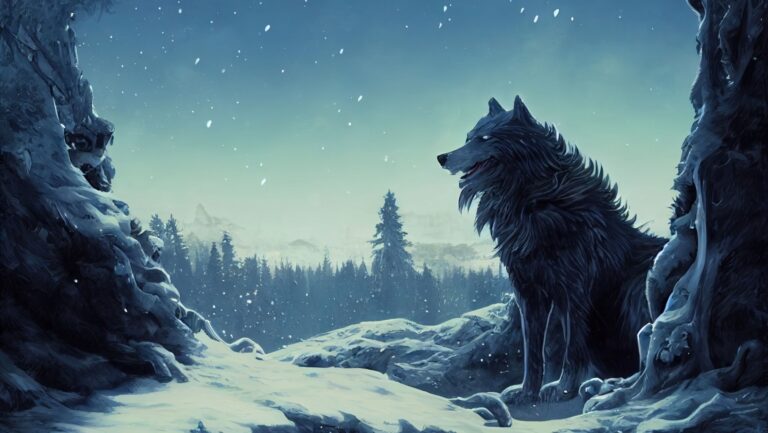
These entities not only populate the realms of iconic literature like “Lord of the Rings” but also form the backbone of the lore in popular video games such as “The Elder Scrolls” series.
These creatures, steeped in magic and mystery, have seamlessly integrated into the fabric of modern fantasy, enriching narratives and worlds with their presence.
The Enduring Legacy of Norse Creatures
However, a lesser-known fact is that the genesis of many of these mystical beings traces back to the lore of Norse mythology.
Rich in tales of heroism, gods, and monsters, Norse mythology serves as the foundational bedrock for much of what has become standard in the fantasy genre today.
In this exploration, we aim to unearth the marvels of Norse mythology, spotlighting not only races like the elves and giants but also singling out legendary individual creatures such as the formidable Kraken and the fearsome Fenrir.
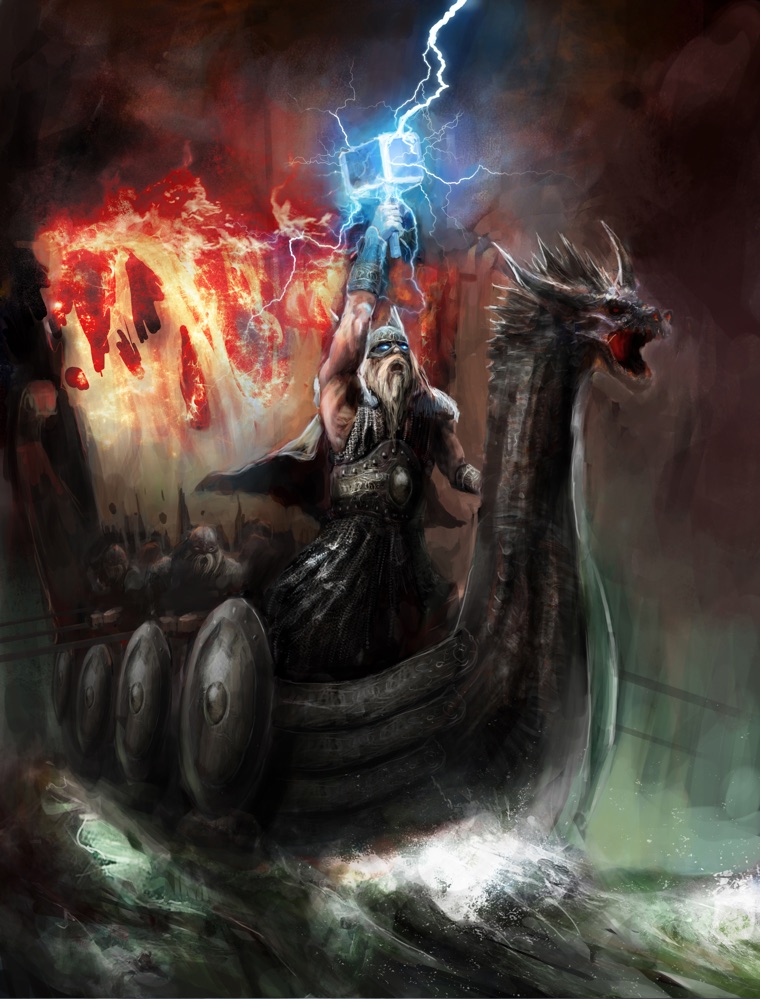
From the ethereal realms of Asgard to the murky depths of Midgard, we traverse the nine worlds to bring you a comprehensive guide to the incredible beings that inhabit them.
Whether you're a seasoned aficionado of Norse lore or a curious newcomer, prepare to be enthralled by the tales of courage, cunning, and conquest that animate these fantastic beasts.
Elves
Said to inhabit the realm of Alfheim, under the rule of the God Freyr, the Elves were tall, slim demi-gods with pale skin and hair, who were more beautiful than the sun.
On the whole the Elves kept themselves away from the affairs of humans, appearing only occasionally to either cause or cure illnesses, based on their whims. They were a very fluid race and did not subscribe to the normal gender roles of humans. Elves were often portrayed as morally ambivalent.
Read more: Norwegian Mythology & Folk Tales
Some sources distinguish Elves into two different groups – Dökkálfar and Ljósálfar – Dark Elves that are ‘blacker than pitch’ and Light Elves that are ‘lighter than the sun’.
This is disputed by many scholars, and the Dökkálfar could either be an attempt to introduce the ‘good vs evil’ concept or they may be Dwarfs under another name.
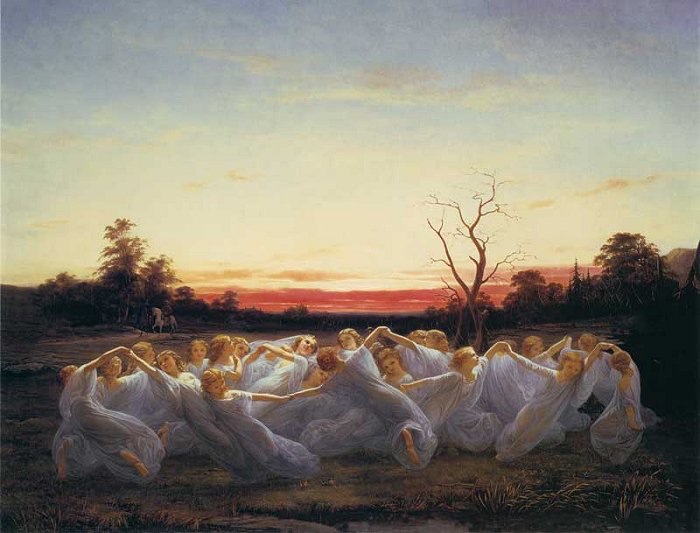
Either way, it’s clear that the Ljósálfar are what we have come to know of as Elves.
Dwarfs
Svartalfheim – literally home of the black elves – is where the Dwarfs live.
Unlike our modern depictions, there is no evidence that Dwarfs were short, stout beings. Instead, they are considered ‘lesser’ beings and so some may have warped this into ‘short’.
Dwarfs dwell in the earth, and Svartalfheim is often thought of as a labyrinthine underground complex of mines and forges. Smithing – making things – is what we think of best when it comes to Dwarfs.
Amongst the incredible artefacts forged by the Dwarfs are Mjollnir – Thor’s hammer – Skidbladnir – a ship belonging to Freyr that always has a favourable wind – and Draupnir and Gungnir – Odin’s ring and spear.
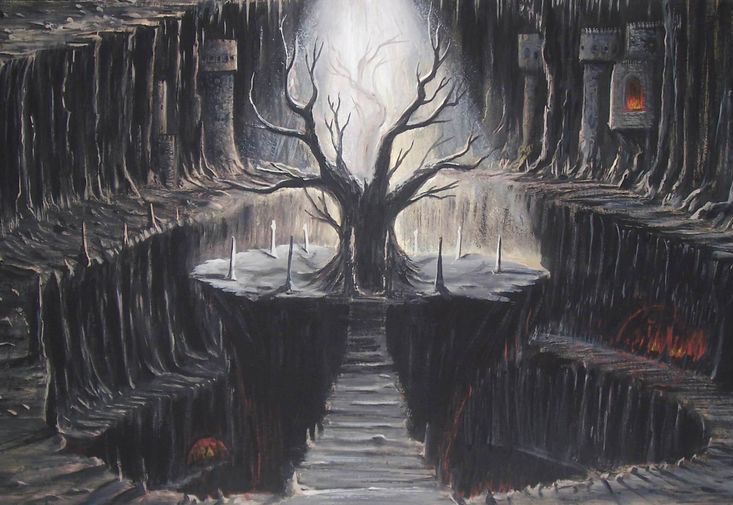
Dwarfs are highly knowledgeable, very wise, extremely skilled and magically powerful. The four Dwarfs Austri, Vestri, Nordri and Sudri – East, West, North and South – hold the sky aloft by its four corners, a testament to their incredible strength.
Jötnar
The Jötnar (singular Jötunn) are an odd bunch, and difficult to define. Despite generally being translated as ‘Giants', they are usually the same size as humans.
Often said to be at war with the Gods of the Æsir and Vanir, nevertheless, many of the Norse Gods themselves are borne of one or more Jötunn. It's perhaps better to consider them as ‘devourers'; chaotic spirits of night and darkness and winter.
We'll get onto a few specific Jötunn later in this article but they include Hel – the Goddess/Giantess of the Underworld and Ymir who is a hermaphroditic entity that is the first being in the Norse creation myth.
Trolls are a subset of the Jötnar.
Valkyries
A stirring rendition of Wagner's Ride of the Valkyries has adorned many a film to good effect but what are the Valkyries?
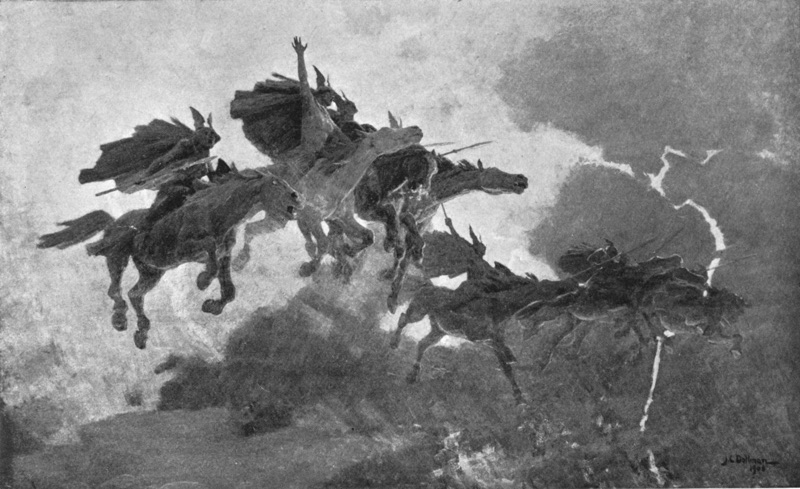
They're Odin's female helping spirits who are depicted as elegant maidens ferrying the slain to Valhalla. A good story but, as always, it's not quite that simple!
It's certainly true that the Valkyries carried the slain to battle but their name – Choosers of the Slain – hints at their more sinister side. They don't simply choose who gets in to Valhalla, they also choose who lives and dies in battle!
Draugr
What mythology is complete without some kind of zombie story? In Norse mythology these are the Draugr.
Read more: The Role of Women in the Viking Age
Draugr are undead beings, with superhuman strength and the stench of decay. They can also increase their size at will and shape-shift into other creatures.
Perhaps most importantly, they can swim through solid rock, which perhaps explains how they exit their tombs.
They spend their days protecting the treasures in their graves and crushing people who attempt to rob them, or who wronged them in their lives.
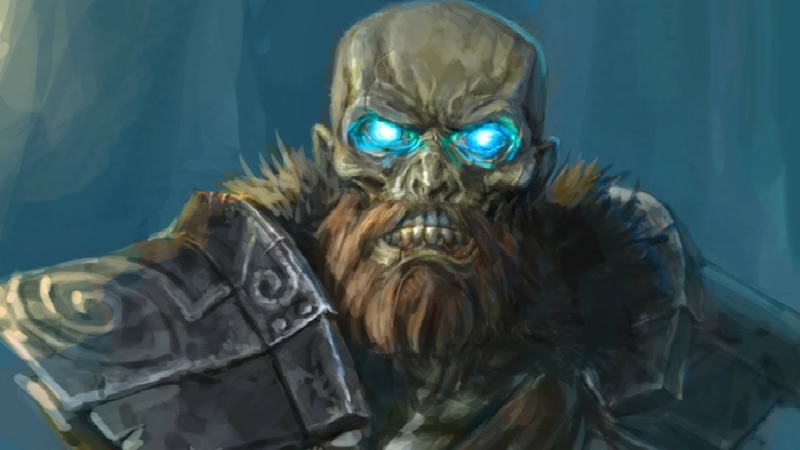
So now we have our classes of being, let's look at a few specific examples of Important Norse Creatures.
Jörmungandr
For humans at least, there are few creatures more important than Jörmungandr. Also known as the Midgard Serpent, he encircles the Earth keeping everything in place.
Jörmungandr is the child of Loki and the Jötunn Angrboða, along with Fenrir and Hel, and was tossed into the ocean by Odin. The serpent grew so large that he was able to surround Midgard and grasp his own tail.
Jörmungandr's arch-enemy is Thor, the God of Thunder. Ragnarok – the End of Days – begins when Jörmungandr releases his tail and comes out of the ocean to poison the sky.
He will be slain by Thor who then drops down dead from being poisoned by his venom. Mutually Assured Destruction!
Fenrir
Another of Loki's delightful children, Fenrir the Wolf is the fiercest and most vicious of all the creatures. Thanks to prophecies noting Fenrir's growth and ferocity, the Gods decided he must be bound.
They tried two strong chains, which Fenrir broke easily, before commissioning the Dwarfs to create Gleipnir.
When the Gods came to tether Fenrir, he didn't trust them so the God Tyr places his hand in Fenrir's mouth as a bargain.
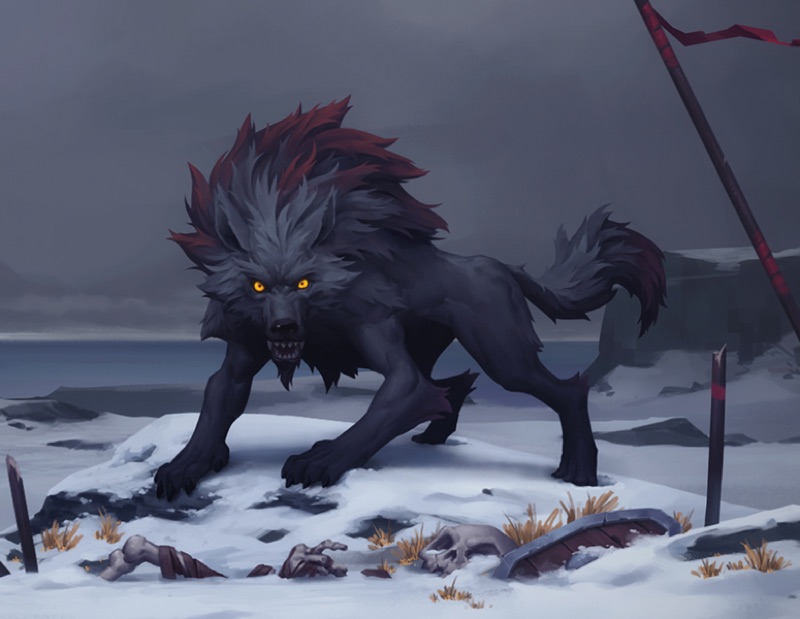
After the Gods had bound him with Gleipnir, a tether that's as thin as silken ribbon but stronger than any chain, he reslised he'd been tricked and bit Tyr's hand clean off.
At Ragnarok, Fenrir will kill Odin and then, in turn, be killed by Odin's son Víðarr.
Sleipnir
Sleipnir, the unparalleled eight-legged steed of Odin, is an example of the complexity and depth of the Norse tales.
Born from the mischievous Loki, who, in a cunning twist of fate and guise, transformed into a mare to beguile the mighty stallion Svaðilfari, Sleipnir is not merely a creature of speed and endurance but also a symbol of the unforeseen and transformative powers inherent in the gods' tales.
As Loki's offspring, Sleipnir transcends the boundaries of conventional mythical creatures, embodying the unpredictable nature of divine interventions.
This majestic horse, esteemed as the best among all horses, carries Odin across the nine worlds, demonstrating an agility and swiftness unmatched by any.
The tale further unfolds as Hermod, the messenger of the gods, mounts Sleipnir in a daring quest to the gloomy realms of Hel.
Their mission: to negotiate the release of the beloved Baldr, whose life was untimely snatched away by a mistletoe dart, guided by the hand of his blind brother Höðr.
This journey underscores Sleipnir's role not just as a mere beast of burden but as a pivotal character, bridging the worlds with his extraordinary capabilities and linking the destinies of gods with the fates of the world.
Huginn and Muninn
Huginn, from the Old Norse for ‘thought', and Muninn, from the Old Norse for ‘mind', are a pair of ravens that fly around Midgard and bring news of the affairs of men to Odin.
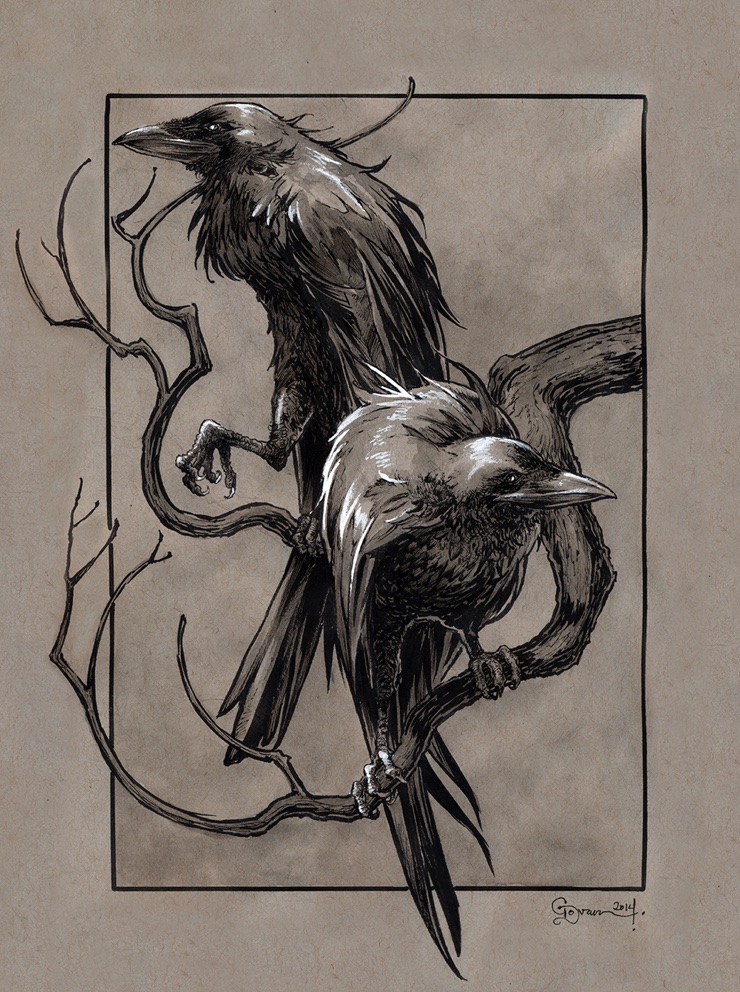
Through their daily travels Odin could keep an eye on his charges and become wise.
Some have linked the two ravens to being a metaphor for Odin casting out his thoughts and his mind in a trance-like practice, and he was known to fear that one day they might not return.
Fossegrim
The Fossegrim is a water spirit who plays enchanting music on the violin. Usually depicted as a beautiful, semi-clad or naked male, the Fossegrim is tale of both good and bad.
On the one hand, the Fossegrim is sometimes known to teach humans how to play the violin as beautifully as he, but only if they sacrifice a goat. If the goat is too lean, the Fossegrim will only teach how to tune the fiddle.
But a sufficiently prime goat will make for a lesson until the player's fingers bleed at which point they will be able to play so well as to make the trees in the forest dance.
On the other hand, he lures women and children to lakes and streams where they drown, which is rather harsh! But as with all parts of mythology, where good things happen, death is usually close by!
Ratatoskr
Ratatoskr, drill-tooth or bore-tooth, is a squirrel who runs up and down Yggdrasil, the world tree, ferrying messages between the eagle Veðrfölnir, who perches atop Yggdrasil, and the serpent Níðhöggr, living beneath one of the three roots of the tree.
Most theories believe that this is to stir up hostilities between the two, spreading slander and gossip. In turn the two attack the tree, leading to a cycle of decay and rebirth that refreshed the tree.
Kraken
Generally depicted as a giant squid or octopus – though sometimes as more of a crab – the Kraken is folklore's big beast of the sea.
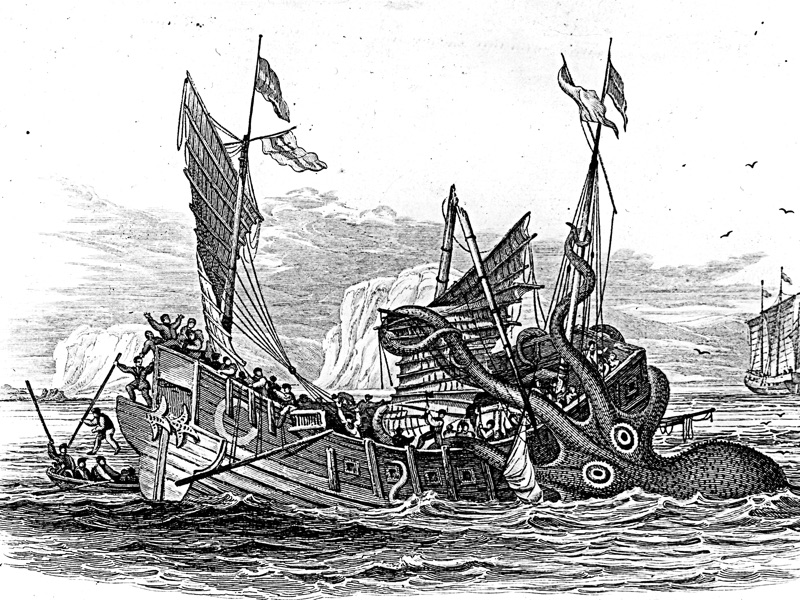
Said to measure more than a mile, its body is so huge than when on the surface it can be mistaken for an island.
Lying in wait in the deep waters, the Kraken rises up when disturbed by boats above. When sailors see its huge size they make for it, believing it to be the shore, only to be pulled downwards to their doom.
The Kraken may be inspired by the existence of the Giant Squid which, at 18m long, is a real monster of the waters. Thankfully, though, the real thing is seldom seen by humans, much preferring the deep, dark depths of the sea.
As you can see, Norse Mythology harbours a huge array of creatures, some more fearsome than others. I'm sure you'll agree, though, that there's not many that you'd want to encounter on a dark night!
Update: Text altered to correct errors flagged up in comments below. Thanks folks 🙂

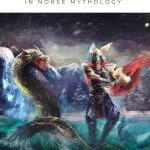

At the paragraph of Elves, you say that they live in Alfheim under the rule of “the Goddess Freyr” but isn’t Freyr a God? Just thought I’d mention it.
yes Freyr is a god, his sister was Freya. Many seem to confuse them.
Isn’t Gungnir Odin’s spear? not sword?
Yes, also I have never found a single depiction of him ever brandishing a sword so I have no idea where they came up with Gungnir being a sword.
Thanks for the comments. I don’t know how those errors slipped through. Sometimes when writing, your brain says one thing and your hands type something else! I’ve updated the text to reflect your corrections. Tusen takk!
You forgot the titan Aurgelmir or otherwise known as Ymir
Aurgelmir, also called Ymir, in Norse mythology, the first being, a giant who was created from the drops of water that formed when the ice of Niflheim met the heat of Muspelheim. Aurgelmir was the father of all the giants; a male and a female grew under his arm, and his legs produced a six-headed son.
these old legends are cool but also very weird
Is there a monster or something that is two plant pots stacked on each other with the top one upside down with something inside it
WHAT ABOUT THE GODS??? plus I am first generation Norwegian and not all this info is true you better change it laddie.
Well you see, this article is about creatures. For the gods, you’ll have to see the article, well, the article that’s about the gods. See how that works?
ah, still not all this information is true a few miss things
You are first generation Norwegian, but use Scottish phrasing? 😯
😉☺️
The gods are a separate link. “Laddie” implies to me you have a parent(s) who are Scottish (I’m Scottish descent) so “first generation” also means you were the first in your family tree born Norwegian. No offense, but not a strong claim to declaring things “not true” and demanding change without citing what changes.
Im 9th generation scandinavian american and its all true, dont let the older generations get you down. I have all the inside information and am a benefactor to all the culture and information. hit me up if you want any inside information.
What can you tell me about the name Svirfneblin? It’s supposedly from Norwegian folklore before being adapted by Dungeons & Dragons. Despite numerous online references, I cannot find the term anywhere in original folklore or mythology sources. There’s even a hero of that people, according to one post. Did the designers of the game just make it up or do these dwarves/gnomes actually appear in real world myth and folklore?
midgard serpent, alsvin, alsvinder, dain, eikthynir, geri and freki, gullenbursti, gullenkambi, gulltop, hiedrun, hildsvini, hrimfaxi, nidhug, saehrimner, skinfaxi, svadilfari, Tanngniost and Tanngrisnir. yu forgot all these lad.
yeah I would like it if there was more of the mirdgard serpent. I think that you mention once, but the serpent is bloody awesome.
I am doing research for a school project, but I kind of took it personal and am trying to dig a bit deeper into Norse Mythology. This has been extremely helpful. Can you suggest othe good articles or sources?
How can the water spirits play the violin when it had not been invented at that time???
The fossegrim actually plays the fiddle – which emerged in the 10th century (late viking age). As the fiddle is very similar to the violin, it’s possible this is the reason for the confusion.
I thought I saw somewhere, a legend about the Goodluck Trolls, it said that, If one of them was to tell you it’s name, well thats how the goodluck was transferred from them to us. Is there such a legend?
I was googling Gods of poetry and stumbled across Bragi, then proceeded to spent the next hour or so falling further down this rabbit hole of knowledge (10/10 would recommend, will probably accidentally hyperfixate on Norse mythology, thank you for putting this together)
Interesting read about Norse mythology. According to my Norwegian mother-in-law Trolls are big in Norse folklore. She really believed in them, said some could be as small as a rat or the size of a mountain. We still have a collection of hand carved wooden Troll dolls sent by my wife’s Grandfather from Norway. They aren’t cute like the Troll dolls sold in the USA. These are somewhat creepy and certainly ugly.
The big trolls she mentioned isnt from norse mythology, but from a later era. You can say they where reinvented during the national romantic era, to add some grandure to Norwegian folk lore.
C’mon guys this is just an article. There’s no God’s the whole Norse mythology was copied by Slavic mythology. And Slavic from Vedic.. etc etc…
That would make for a very boring article, eh? This isn’t an article arguing the veracity of truth to these beings existence, its article detailing a particular culture’s interpretation of myths and legends.
I’m searching for the light hearted music from the Lillehammer Olympics 1994. As little creatures popped out of the snow? Classed as mischievous. My son bought me a CD in 1996 or 7 and since my son disappeared, that music is precious to me and the tape was lost in a move! Does anyone know of the quirky Band producing music not in the popular circles. Parts of it were similar to the 1972 POPCORN song. Sentiment keeps me searching for the music. Ideas anyone?